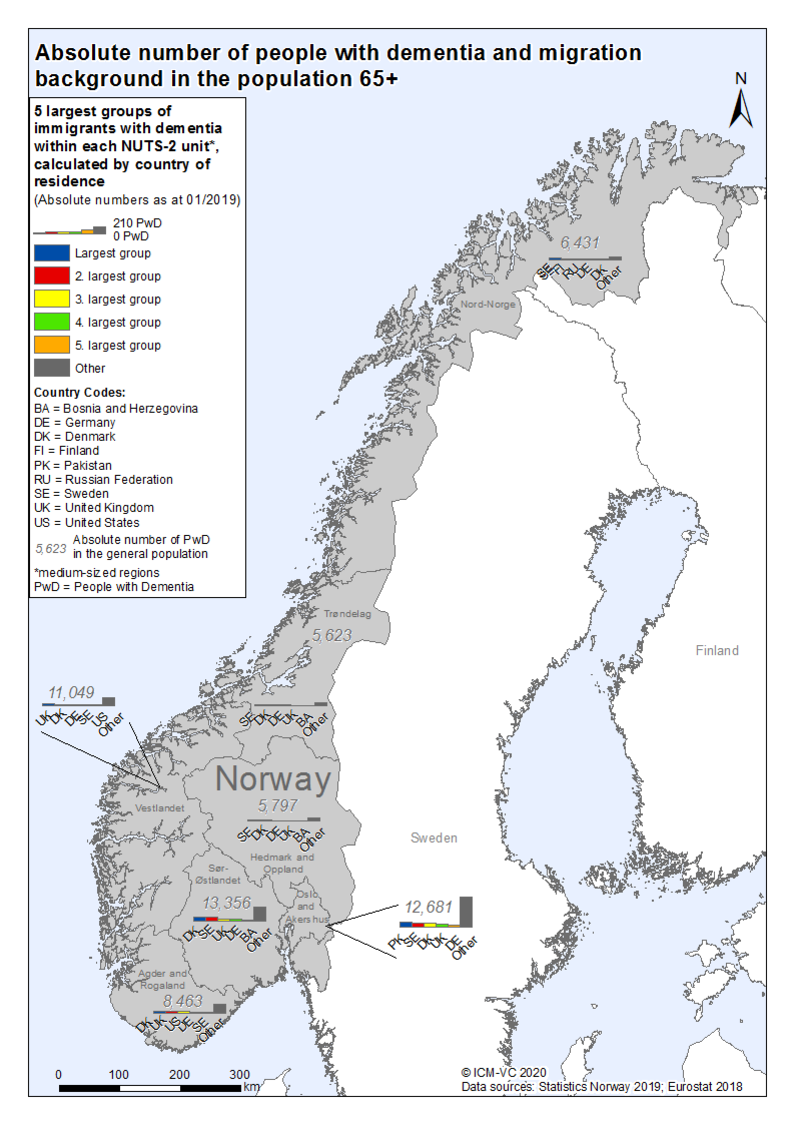EU-Atlas: Dementia & Migration
| Largest group | 2. largest group | 3. largest group | 4. largest group | 5. largest group | |
| Absolute numbers | |||||
| PwMD per 100,000 inhabitants 65+ |
| Absolute numbers | PwMD per 100,000 inhabitants 65+ | |
| Largest group | ||
| 2. largest group | ||
| 3. largest group | ||
| 4. largest group | ||
| 5. largest group |
| Prevalence per 100,000 inhabitants 65+*, calculated by country of residence | |||
|---|---|---|---|
| high > PwMD |
minor > - PwMD |
||
| increased > - PwMD |
low ≤ PwMD | ||
| medium > - PwMD |
|||
| PwMD = People with a Migration background with Dementia *Bulgarien, Litauen, Malta, Polen in der Bevölkerung 60+ |
|||
| Absolute number of PwMD 65+ | |
| PwMD per 100,000 inhabitants 65+ |
Norway
First, Norway was an emigration country. Between 1825 and 1945, about 850,000 people left the country. After creating a common labour market between Norway, Sweden, Finland, and Denmark in the 1950s, many people migrated from neighbouring Scandinavian countries. In the 1960s, migrant workers came to Norway, e.g. from Morocco or Turkey. Labour migration and family reunification characterized immigration until the immigration stop in 1975. From 2004 onwards, significant migratory flows came from Sweden, the Russian Federation, Denmark, and Poland1. Between 1990 and 2019, the migrant population (born abroad) more than quadrupled (192,600 to 867,800). At the same time, the proportion of migrants in the population has risen from 4.5 to 16.1%2.
There are 53,500 people with a migration background aged 65 or older. Of those, approx. 3,690 are estimated to exhibit some form of dementia. Calculations show that the most affected migrant groups presumably originate from Sweden (approx. 400), Denmark (approx. 400), Great Britain (approx. 300), Germany (approx. 200), and Pakistan (approx. 200)3.
Three national dementia plans have been identified and all consider migration or linguistic/ethnic minorities4-6, particularly in the current Norwegian Dementia Plan (2020). There, people with ethnic minority backgrounds with dementia are identified as a population with specific needs that the government and care providers already focus on but need to pay more attention to in the future. Existing problems and disparities in care for minorities and migrants are detailed and a significant framework for action is included7. The ‘National Professional Guidelines on Dementia’ (2017) includes a separate section on ‘People With Minority Backgrounds With Suspected Dementia’. The focus is on describing challenges in diagnosing dementia and existing care barriers and needs. Specific recommendations for action are given to service providers, e.g. utilising the intercultural screening tool RUDAS for people without higher education and with other cultural and linguistic backgrounds8.
Dementia and migration seem to be relatively unimportant in Norway as a whole. The existing development centres for nursing homes, home care services, and care research centres do not focus on this topic. In outpatient and inpatient care, formal services are available nationwide to migrants with dementia. However, they often lack access to care. The current specialised care services for migrants with dementia seem to be far from adequate in terms of meeting their needs.
Culturally sensitive care is partly included in the healthcare professional’s qualifications. There is a nationwide availability of intercultural care courses for healthcare professionals. Still, the need for culturally sensitive care is currently not met by sufficiently qualified professionals.
Family networks, migrant organisations, religious communities, and voluntary organisations are important in supporting family caregivers of migrants with dementia. There is still a great lack of specialised information and accessible support services for these family caregivers.
References
- Cooper B: Norway: Migrant Quality, Not Quantity. [https://www.migrationpolicy.org/article/norway-migrant-quality-not-quantity]. Accessed 04 May 2020.
- International Organization for Migration: Total number of international migrants at mid-year 2019: Norway; 2019.
- Statistics Norway: Sonderanfertigung. In. Oslo: Statistics Norway; 2019.
- Ministry of Health and Care Services: Dementia Plan 2015; 2008.
- Ministry of Health and Care Services: Dementia Plan 2020: a More Dementia-friendly Society; 2016.
- Ministry of Health and Care Services: Dementia Plan 2025; 2020.
- Helsedirektoratet: Nasjonal faglig retningslinje om demens. In. Edited by Helsedirektoratet; 2017.



![[Translate to Englisch:] Logo RBS [Translate to Englisch:] Logo RBS](/fileadmin/_processed_/9/7/csm_RBS_Logo_RGB_0e245a98a4.jpeg)